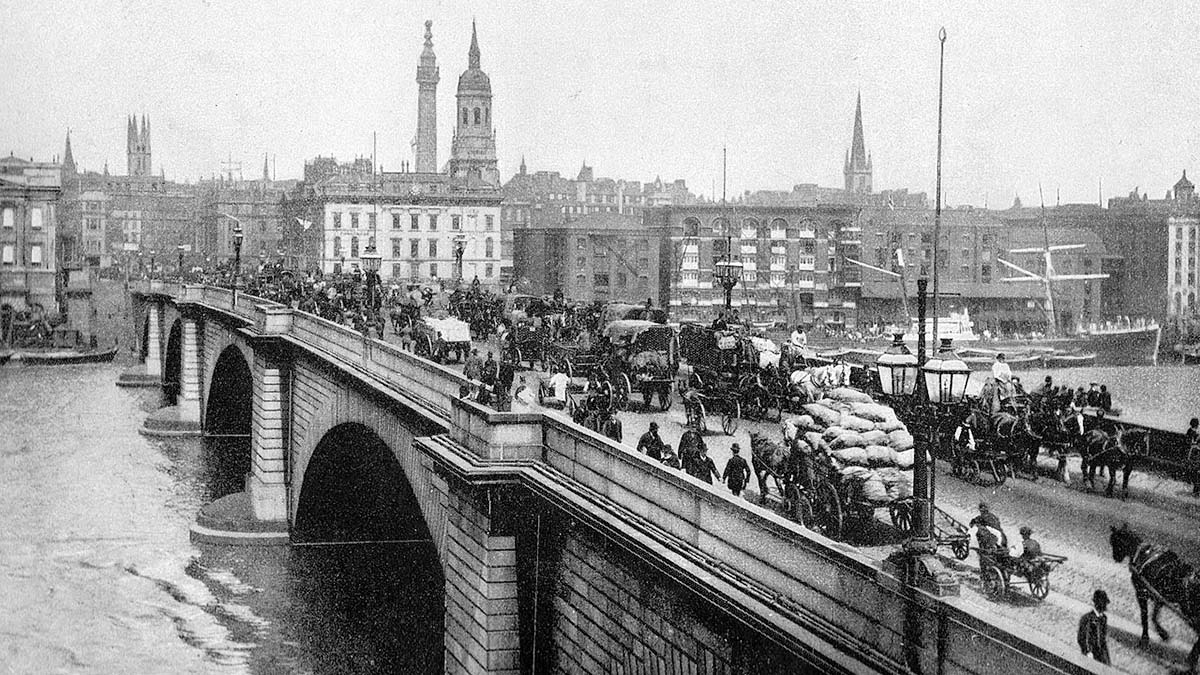
by Lesley Hebert
In 1967 the City of London tried to sell London Bridge. Erected in 1831, the bridge was designed to carry horse-drawn traffic and was now inadequate for the demands of motor traffic, and slowly sinking into the soft muddy bed of the River Thames. Consequently, it was to be auctioned off to the highest bidder.
In 1967 I was working in London. To me, London Bridge was an unremarkable piece of masonry blackened by 136 years of coal smoke belching from London chimneys and I found the idea of selling the bridge quite bizarre. Who on earth, I wondered, would buy this dirty pile of old stones?
As it turns out, an American businessman bought the bridge and transported it across the Atlantic, thus leading to the growth of an urban myth that:
♦ He was a stupid American with more money than sense
♦ He thought he was buying Tower Bridge
♦ He was putting the bridge in the middle of the desert and then building a river under it.
The buyer was American entrepreneur Robert P. McCulloch, who had amassed a sizable fortune from boat engines, chainsaws, energy exploration, and property development. In 1963 he had paid $75 an acre for 26 square miles of seemingly worthless Arizona scrub land, and now he was buying a second-hand bridge. No wonder he was developing a reputation for eccentricity.
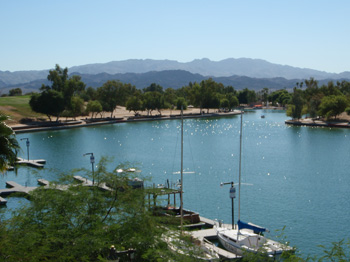 But closer examination of the burgeoning urban legend reveals that McCulloch was actually a shrewd businessman with a vision and a plan. The Arizona desert land he bought was a bargain. While not situated near any major highways, it was a popular fishing destination on the banks of Lake Havasu, a 45 mile long reservoir formed when the Parker Dam was built on the Colorado River in the 1930s.
But closer examination of the burgeoning urban legend reveals that McCulloch was actually a shrewd businessman with a vision and a plan. The Arizona desert land he bought was a bargain. While not situated near any major highways, it was a popular fishing destination on the banks of Lake Havasu, a 45 mile long reservoir formed when the Parker Dam was built on the Colorado River in the 1930s.
While the bridge cost McCulloch $2,460,000 plus relocation expenses, he recouped much of his investment by selling the granite core in the UK and shipping only the outer facade, which he then reconstructed over a new concrete support. The notion that such an astute businessman thought he was buying Tower Bridge is obviously false. In fact, a 2013 travel article in The Guardian speculated that McCullough started the rumour himself.
However, he actually did erect the bridge on land before putting water underneath. As a way of simplifying construction, he put it up at the base of a peninsula jutting out into Lake Havasu, and created an island by digging a mile long canal across the peninsula and under the bridge.
Mr. McCulloch then began to develop Lake Havasu City as a tourist destination and planned retirement community. He launched an extensive marketing campaign and bought a fleet of planes to fly prospective buyers to the city site where he put them up in a purpose-built luxury hotel.
Visiting Lake Havasu
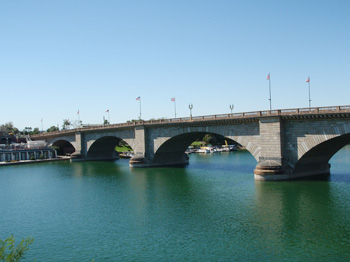 Two years after Mr. McCulloch’s purchase of London Bridge, I emigrated to Vancouver, Canada and forgot about London Bridge. Then in 1992 My husband and I decided to take a road trip, and were returning home from Disneyland via Las Vegas. I saw Lake Havasu City on the map and decided I simply had to see the bridge in its new home.
Two years after Mr. McCulloch’s purchase of London Bridge, I emigrated to Vancouver, Canada and forgot about London Bridge. Then in 1992 My husband and I decided to take a road trip, and were returning home from Disneyland via Las Vegas. I saw Lake Havasu City on the map and decided I simply had to see the bridge in its new home.
My memories of London Bridge generally involved rainy days, muddy River Thames water and grey London skies. However, this time I encountered the bridge in Lake Havasu on a hot summer afternoon after having spent two days in the make believe world of Disney’s Magic Kingdom. Flanked by palm trees, baking beneath clear desert skies, the bridge waved and shimmered in the hot desert air. In front of it were metal griffins displaying the city of London coat of arms and a miniature replica of Trafalgar Square. The whole experience seemed quite surreal. It became even more surreal when I walked down to the lake past shops and a public house located in a faux English Tudor village and saw two Venetian gondolas moored beneath beneath the bridge. I felt as if I was in a bizarre extension of Disneyland where the park designer had created a whimsical facade confusing Venice and London.
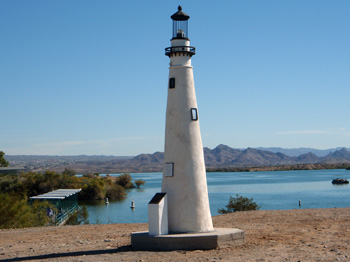 The London Bridge Interpretive Center, however, was more down to earth. It provided fascinating information about the three-year project to relocate the bridge. When the bridge was dismantled, each piece of granite was carefully numbered to indicate its position in the structure. The pieces were then shipped from London to California via the Panama Canal, from where they were trucked to Lake Havasu.
The London Bridge Interpretive Center, however, was more down to earth. It provided fascinating information about the three-year project to relocate the bridge. When the bridge was dismantled, each piece of granite was carefully numbered to indicate its position in the structure. The pieces were then shipped from London to California via the Panama Canal, from where they were trucked to Lake Havasu.
As I walked across the bridge the reality of the situation began to sink in. The bridge sported flagpoles, some flying the Stars and Stripes and others flying the Union Jack. All along the bridge were beautiful old lampposts which I learned at the Interpretive Center had been made from melted down cannons captured in the battle of Waterloo. Looking at the parapet, I was sobered to see that chunks of stone had broken off and realized this was bomb damage from World War Two. Standing there in the clear air of the Arizona desert, I found it hard to imagine the constant wartime bombardment that Londoners had suffered during the Blitz, but the evidence was clearly there, and yes, this was the same bridge I had walked across a five thousand miles away and a quarter of a century ago.
The Disneyland connection
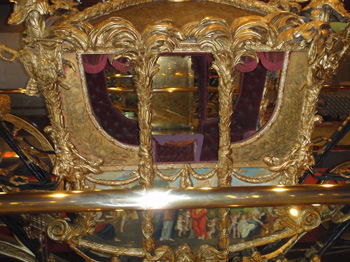 My sense that Lake Havasu was an extension of Disneyland was actually not far from the truth. To develop Lake Havasu McCulloch partnered with C.V. Wood, the president of the McCulloch Oil Corporation. Wood had previously assisted Walt Disney to develop Disneyland, and was subsequently involved in creating the first Six Flags Adventure Park. It was Mr. Wood who supervised the entire bridge moving project, and who undoubtedly gave the new planned community of Lake Havasu City its theme park flavour.
My sense that Lake Havasu was an extension of Disneyland was actually not far from the truth. To develop Lake Havasu McCulloch partnered with C.V. Wood, the president of the McCulloch Oil Corporation. Wood had previously assisted Walt Disney to develop Disneyland, and was subsequently involved in creating the first Six Flags Adventure Park. It was Mr. Wood who supervised the entire bridge moving project, and who undoubtedly gave the new planned community of Lake Havasu City its theme park flavour.
Lake Havasu today
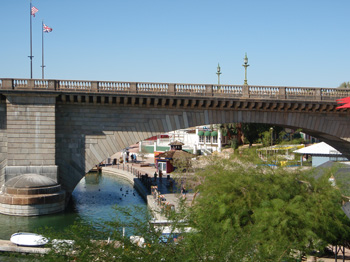 I returned to Lake Havasu in 2014. The population of Lake Havasu has grown dramatically since 1992. There are housing developments all along the lake, and the island is covered with condominiums and resorts.
I returned to Lake Havasu in 2014. The population of Lake Havasu has grown dramatically since 1992. There are housing developments all along the lake, and the island is covered with condominiums and resorts.
The desert air seemed to have been kind to the old bridge. The formerly soot-blackened granite now glowed gold in the desert sun. It had either been cleaned or naturally sand-blasted by desert winds, but either way it looked almost as new and clean as it must have appeared in the early nineteenth century. The griffins still stand guard over a miniature Trafalgar Square, and the Union Jacks still fly alongside the Stars and Stripes, but the English village seems to have seen better days. The pub and souvenir shops have closed and the Tudor facade is now painted an ugly purple with garish red timbers. However, there is now a new element of Disneyesque whimsy: 18 one-third scale lighthouse replicas located along the lakeshore. These are working lighthouses which have been put there for the safety of nighttime boaters.
If You Go:
Where to stay
There are a number of hotels and timeshares in Lake Havasu City in addition to the original London Bridge Resort. Prices and availability can be found at tripadvisor.com We stayed at the London Bridge Resort, which presents guests with over-the-top British kitsch out-Disneying Walt Disney himself. The first thing you see as you enter the lobby is a life-sized papier mache replica of the British coronation coach, complete down to the finest detail. Behind the front desk is an enormous carved wooden panel depicting various naked mythological figures including a naked St. George fighting a gigantic carved dragon.
Once I got past the coronation coach and navigated the check in procedure, I discovered this is actually a nice resort with a friendly, helpful staff. Our suite was recently remodeled, we spent time in one of the three pools almost every day, and went to happy hour at the bar every afternoon. The resort offered various daily activities. Most were disappointing, but they did provide an informative free bus tour.
Havasu is a boater’s paradise. We took a boat tour of the lake and enjoyed watching wealthy boat owners trying to outdo each other with the size of their engines. And yes, apparently in the summer you can still see gondolas on the lake.
♦ For more information on the history of London Bridge, visit the website of the London Bridge Museum and Educational Trust.
♦ To learn more about Lake Havasu City read about the history of Lake Havasu City.
Getting there
♦ By car: Lake Havasu is a two and a half-hour drive south from Las Vegas on US 95.
♦ By plane: The nearest major airport is McCarren International Airport, Las Vegas. For those who do not wish to rent a car there are several shuttle services between McCarren and Lake Havasu City, including the daily Havasu/Vegas Express.
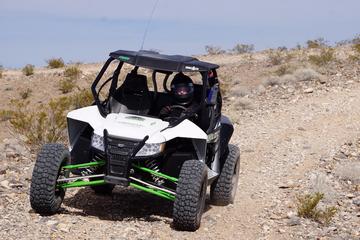
Desert Off Road Adventures in Las Vegas
About the author:
Lesley Hebert is a graduate of Simon Fraser University. Now retired from teaching English as a second language in the classroom, she still teaches ESL to international students via Skype. She also writes on-line articles which reflect a lively, inquiring mind and love of travel, language, history and culture.
Photo credits:
London Bridge, City of London, 1900 by John L.Stoddard (died 1931), Scan by Robert Schediwy / Public domain
View of Lake Havasu by Mike Hebert
London Bridge at Lake Havasu by Mike Hebert
One of the many replica lighthouses dotted around Lake Havasu by Mike Hebert
Papier mache replica of the British coronation coach on display in the lobby of the London Bridge Resort by Lesley Hebert.
Close up of London Bridge, showing the flags and antique lamp standards by Mike Hebert.


